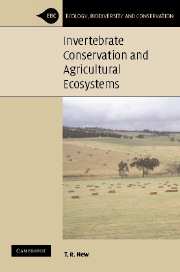Book contents
- Frontmatter
- Contents
- Preface
- Acknowledgements
- 1 Introduction: agricultural ecosystems and conservation
- 2 Agriculture and biodiversity: the place of invertebrates
- 3 Agriculture: effects on invertebrate diversity and conservation
- 4 Agricultural disturbance: diversity and effects on invertebrates
- 5 Biological control and invertebrate conservation
- 6 Cultural aspects of pest management
- 7 Extending beyond cropping areas
- 8 Field margins and landscape ecology
- 9 Pasture management and conservation
- 10 Towards more holistic management for invertebrates
- References
- Index
3 - Agriculture: effects on invertebrate diversity and conservation
Published online by Cambridge University Press: 29 July 2009
- Frontmatter
- Contents
- Preface
- Acknowledgements
- 1 Introduction: agricultural ecosystems and conservation
- 2 Agriculture and biodiversity: the place of invertebrates
- 3 Agriculture: effects on invertebrate diversity and conservation
- 4 Agricultural disturbance: diversity and effects on invertebrates
- 5 Biological control and invertebrate conservation
- 6 Cultural aspects of pest management
- 7 Extending beyond cropping areas
- 8 Field margins and landscape ecology
- 9 Pasture management and conservation
- 10 Towards more holistic management for invertebrates
- References
- Index
Summary
Loss of ecosystem functions previously provided by invertebrates may need to be compensated for in agroecosystems by costly human intervention, such as increased applications of agricultural chemicals. Threats to invertebrates from agriculture are outlined and discussed in this chapter, with particular emphasis on the influences of habitat change and simplification and the effects of exotic species. Particular invertebrates may be endangered by agriculture and thus become targets for species-focused conservation programmes; others may be used as monitors of the wider effects of such changes and are sensitive functional indicators of wider community changes at levels otherwise difficult to determine.
Introduction: a central paradox
There is no reasonable doubt that agriculture has had dramatic effects on invertebrates and has been associated with decline and local extinction of many species. Although the causes of these losses are diverse, much recent attention has devolved on issues related to crop protection, predominantly the control of pests. Crop protection in agriculture is involved largely with measures to kill insects and, more rarely, other invertebrates as major pests. These organisms commonly are related closely to many other species in natural environments, and some of those may be of specific conservation concern in addition to being constituents of wider biodiversity without adverse effects on human wellbeing. Many insects disperse actively and, indeed, such dispersal can be important in crop and pest management so that optimal management – although focused largely on cropping or other production areas – commonly may need to incorporate wider considerations.
- Type
- Chapter
- Information
- Invertebrate Conservation and Agricultural Ecosystems , pp. 53 - 84Publisher: Cambridge University PressPrint publication year: 2005



